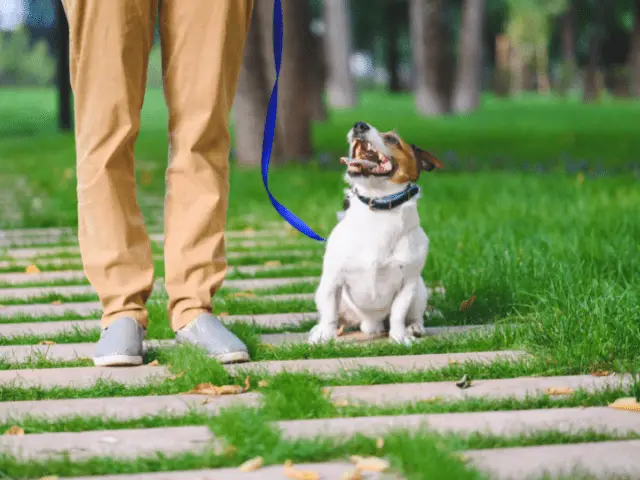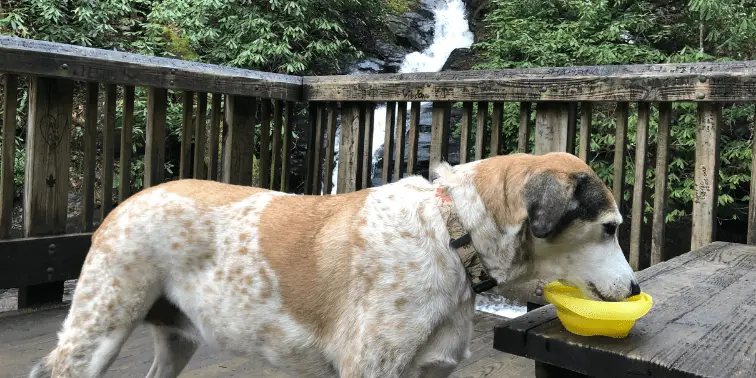Hiking with your dog in the mountains can be incredibly fun and rewarding, but it’s important to take some precautions to make sure your pups are having as much fun as you are. This article will explain what you need to do to keep your dogs safe on mountain hikes.
Make sure you and your dog are prepared for the journey, especially if it is a multi-day trip. You’ll need supplies for both you and your dog.
This article contains affiliate links. If you make a purchase through one I may receive a commission.
The 5 Things Your Dog Should Have Before Taking Them into the Mountains
We hope to encourage you to take your dog backpacking by explaining why and how he can safely enjoy an overnight mountain excursion, and to encourage those who’ve considered it but are still unsure how. You’ll need to do some homework before going into uncharted territory, so consider these ten tips before setting out on your adventure with your dog.
Leash Training

You’ll need to train your dog on a leash before taking him out on a trail. Practice by walking around your neighborhood, as well as visiting some of your local parks for off-leash playtime.
Coming When Called Training
When hiking, you will also want to practice coming when called and responding to their name from a distance, especially if there are other dogs present. And while he knows how to respond when you say sit or lie down, make sure that response holds up when distractions like squirrels or bunnies come into play.
An All-Clear from Their Vet
You’ll want to be sure that your dog is physically fit enough for an excursion like this before you embark on it. Your local vet can help you determine what shape he’s in, as well as give any final recommendations on gear and training he might need before going out there.
You’ll also want to know his limits; will he become overheated or stressed by his surroundings? Make sure he knows how to take a break if needed, and that you are able to recognize when it is. This is especially true if you have an older dog.
Leave It Training
Can your dog leave a tasty treat and pay attention to you instead? This can come in handy if they find something strange on the trail that you don’t want them getting into!
Keeping your dog from interacting with potentially dangerous plants and animals (like snakes for example) is key to a safe, successful hike. You can practice this training at home with various levels of high-value treats.
You’ll want to consider both their physical and mental state before heading out on an adventure, especially if it is a multi-day hike. If you can see signs of over-excitement or restlessness coming on, will you be able to handle it?
Know Your Limits and Your Dog’s Limits

It can be a challenge to keep your dog under control while hiking. Before you take him on a hike, make sure he’s strong enough to complete it without getting tired, and start off on an easy trail that doesn’t involve any uphill climbs.
Dogs can get altitude sickness just like humans. Make sure you talk to your vet about safe altitudes for your dog to handle. Typically, smaller dogs can’t go as high as larger dogs. Older dogs also can’t go as high as younger ones.
Make sure you take frequent water breaks for your dog and give them clean water that you have packed. It’s especially important to take breaks during very hot or very cold hikes. And remember, if you wouldn’t drink from a water source then you shouldn’t allow your dog to either.
If your dog is especially excited, they may fail to tell you when they need a break. Always err on the side of too many breaks rather than too few breaks!
While you’re hiking, make sure that you keep an eye on your dog. Look for signs of weariness, as well as injury or exhaustion.
If your dog seems tired, give him a break and try not to push him to continue too far. If he looks like he’s been injured, call a veterinarian immediately for advice on what course of action to take next. Never leave your dog behind when hiking; it could result in injury or death.
Pack A Bag For Both Of You
It’s crucial to pack your dog’s essentials and keep them within reach. Consider packing:
- A first aid kit
- Water
- Food (both water and dry)
- Paw protection (e.g., booties or paw pad ointment)
- A leash
- A collar with ID tags
- A harness for hiking

- Poop bags
You may also want to bring along some of his favorite toys or treats! Just make sure you never leave your dog alone while hiking as it could be risky if he is injured.
Keep in mind that when hiking, it’s not just about how far you travel; it’s about how steep and rocky trails are as well. Your goal should be to move forward at a moderate pace. If you go too fast, your pup may become tired or winded before finishing his hike.
Bring Water, First Aid Supplies, and Emergency Gear

A human or dog hiker can get hurt on a trail and may need first aid assistance. Before you begin hiking, remember to bring enough water and food for your dog and yourself.
Water, especially, is crucial when traveling in high altitudes and can be difficult to find if you get lost or something goes wrong. It’s also important to bring first aid supplies for both you and your pet; hypothermia can set in rapidly at high altitudes, so it’s helpful to have hand warmers or extra clothes as well as pain relievers like ibuprofen for humans.
for both you and your pet; hypothermia can set in rapidly at high altitudes, so it’s helpful to have hand warmers or extra clothes as well as pain relievers like ibuprofen for humans.
Don’t forget to pack a well-stocked first aid kit. Not only will it have bandages and basic pain relievers, but it should also include gauze, dog splints, and booties for dogs who are at risk of spraining their paws.
Make sure you bring information about your pet’s immunizations as well; mountain travel requires shots for protection against rabies and tetanus, as well as fleas, ticks, heartworm disease, Lyme disease, and more.
as well; mountain travel requires shots for protection against rabies and tetanus, as well as fleas, ticks, heartworm disease, Lyme disease, and more.
If you don’t have proof of current vaccinations on hand, animal hospitals at high altitudes may be able to treat your dog while you wait or recommend local vets who can provide them.
Never Leave Your Dog Alone At Camp
It’s important to remember that at any time, your dog could get spooked and run away. Always keep your dog on a leash when you’re camping.
If your dog does run off, you have to be prepared for a search and rescue mission. In addition to having identification tags on your dog, you should carry a detailed description of your pet’s physical appearance and a printed picture.
It’s good to have several copies of your dog’s picture ready so that you can give them to others on the trail to keep an eye out for them. It’s also important to have information about any medication your dog takes and their vaccination records on hand.
With these precautions, you and your dog can have a great time hiking and camping in the mountains! Talk to your vet if you have any additional concerns about hiking with your dog.
Final Thoughts
Safely hiking in the mountains with your dogs comes down to planning, preparation and being alert and engaged with how your dogs are responding.
Make sure to pick a trail that is rated for what they can safely handle. Double check that you’re bringing the proper supplies needed for you and your four-legged hiking partners. Finally, keep an eye on your dogs and make sure they are responding well to the journey!
If you live (or are visiting) the eastern US, we have an even more specific guide for Hiking the Smokey Mountains with your dog!
